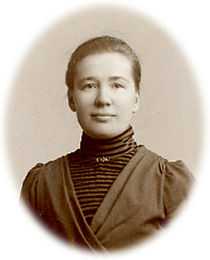Gertrud Månsson

Gertrud Månsson (1866–1935), was a Swedish municipal politician (Social democrat). She was the first female member in the Stockholm City Council, and also the first elected female politician of her country as a whole (1910).
Gertrud Månsson originally supported herself as a maid, and later opened a shop in Stockholm. She was forced to end school to support herself at the age of eleven, but educated herself by Autodidacticism and engaged in politics. In 1892, she became a member of Socialdemokratiska Kvinnoklubben (The Social Democratic Women's Club), and in 1902, she was elected to the first board of the newly founded Women's Trade Union. In 1909, both genders became eligible in local elections, and in the municipal elections of 1910-1911, the first 37 women were elected to various city councils around the country, among them two for the capital's city council: the social democrat Gertrud Månsson and the right wing Valfrid Palmgren. As the votes was counted in the capital first, and the votes from the area electing Månsson was finished before the area electing Palmgren, Gertrud Månsson was the first woman elected in Sweden.
Månsson were characterized as a wise and independent person with the qualities of a leader. When she took place in the city council, a wealthy merchant asked her whether or not they were not already acquainted, as he seemed to remember her, and she answered: "Yes, I served s a maid at the upper classes and use to buy groceries in your shop!" She as well as Valfrid Palmgren was interviewed by the paper Idun, where she commented: "What is to be done, I can not say now, before I have had the time to acquaint myself with the details of the office. But if I can ever in even some degree be of use to better the appalling living conditions, the source of so much discomfort and misery, it would be the greatest joy to me. But me, what can I do, other than what life have taught me?"
Gertrud Månsson was a member of the Stockholm city council in 1910-1915 and in 1919-1931.
References
- http://www.arbetarrorelsenstankesmedja.se/files/infonrett.pdf
- http://hem.bredband.net/b327447/bok/arbetarrorelsens.pdf
- Anne-Marie Lindgren & Marika Lindgren Åsbrink: ”Systrar, kamrater!: arbetarrörelsens kvinnliga pionjärer. Idé och Tendens.” Arbetarrörelsens Tankesmedja
- http://www.marxistarkiv.se/kvinnofragan/e-schmitz-kvinnor_kamrater.pdf
- http://www.arbark.se/2007/12/boktips-i-december-2007/
- http://www.ub.gu.se/kvinndata/digtid/03/1910/dagny1910_12.pdf
- http://www.ub.gu.se/fasta/laban/erez/kvinnohistoriska/tidskrifter/idun/1910/pdf/1910_14.pdf
- http://www.kvinnofronten.nu/Formodrar/gertrud-mansson.htm